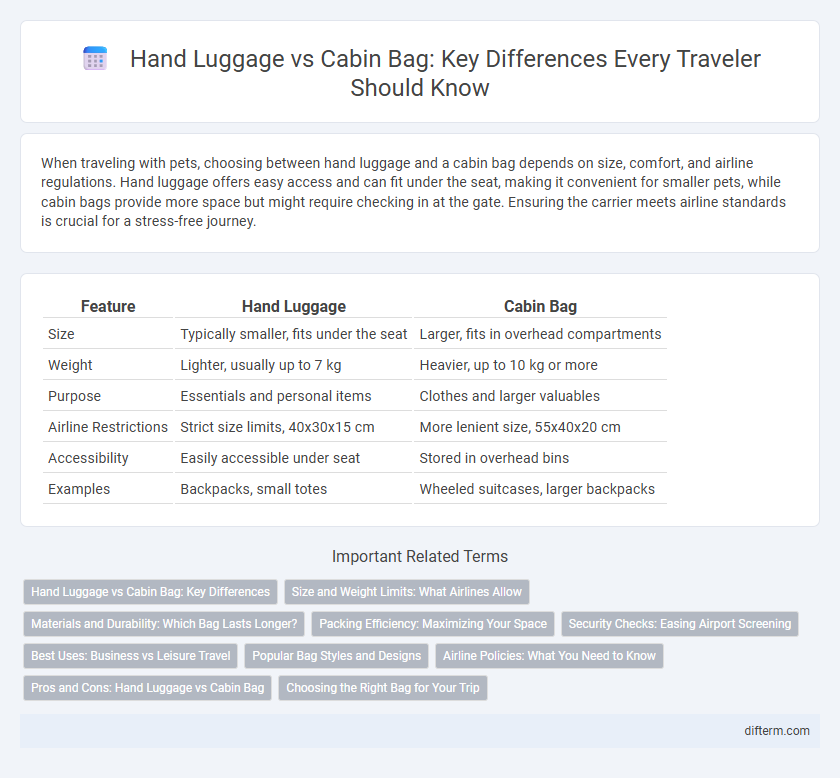When traveling with pets, choosing between hand luggage and a cabin bag depends on size, comfort, and airline regulations. Hand luggage offers easy access and can fit under the seat, making it convenient for smaller pets, while cabin bags provide more space but might require checking in at the gate. Ensuring the carrier meets airline standards is crucial for a stress-free journey.
Table of Comparison
| Feature | Hand Luggage | Cabin Bag |
|---|---|---|
| Size | Typically smaller, fits under the seat | Larger, fits in overhead compartments |
| Weight | Lighter, usually up to 7 kg | Heavier, up to 10 kg or more |
| Purpose | Essentials and personal items | Clothes and larger valuables |
| Airline Restrictions | Strict size limits, 40x30x15 cm | More lenient size, 55x40x20 cm |
| Accessibility | Easily accessible under seat | Stored in overhead bins |
| Examples | Backpacks, small totes | Wheeled suitcases, larger backpacks |
Hand Luggage vs Cabin Bag: Key Differences
Hand luggage generally refers to smaller personal items like handbags or laptop bags allowed in the cabin, while cabin bags are larger suitcases or backpacks designed to fit in overhead compartments. Airlines often specify size and weight limits for cabin bags, typically around 55cm x 40cm x 20cm and 7-10 kg, whereas hand luggage dimensions are more flexible but must fit under the seat. Understanding these distinctions helps travelers comply with airline policies and avoid additional fees during boarding.
Size and Weight Limits: What Airlines Allow
Airlines typically set hand luggage size limits at 55 x 40 x 20 cm, while cabin bags often allow slightly larger dimensions, up to 56 x 45 x 25 cm, depending on the carrier. Weight restrictions vary widely, with many budget airlines imposing limits between 7 to 10 kg for hand luggage, whereas cabin bags can sometimes weigh up to 15 kg. Always check the specific airline's policies, as compliance with size and weight limits ensures smooth boarding and avoids extra fees.
Materials and Durability: Which Bag Lasts Longer?
Hand luggage and cabin bags often differ in materials, with hand luggage commonly made from soft fabrics such as nylon or polyester, offering flexibility but less resistance to wear. Cabin bags are typically constructed from hard-shell polycarbonate or aluminum, providing superior durability and impact protection during travel. Polycarbonate cabin bags are especially known for their longevity, resisting scratches and dents better than fabric hand luggage.
Packing Efficiency: Maximizing Your Space
Hand luggage and cabin bags differ in size and compartments, impacting packing efficiency and space utilization. Cabin bags often offer structured compartments and expandability, allowing travelers to organize essentials and maximize capacity within airline size limits. Choosing lightweight, compressible items and using packing cubes optimizes space in both hand luggage and cabin bags for efficient travel packing.
Security Checks: Easing Airport Screening
Hand luggage and cabin bags undergo similar security checks, but cabin bags often offer more streamlined options for organizing liquids, electronics, and documents to meet airport screening requirements efficiently. Choosing cabin bags with multiple compartments and transparent pouches can significantly reduce the time spent at security checkpoints by allowing quick access to items that require separate inspection. Efficient packing and compliance with TSA or EU regulations for hand luggage dimensions ensure a smoother and faster security screening experience at airports worldwide.
Best Uses: Business vs Leisure Travel
Hand luggage suits business travel with compact items like laptops and documents, enabling quick access and efficient packing for short trips. Cabin bags offer more spacious storage ideal for leisure travelers carrying extra clothes, toiletries, and souvenirs on longer journeys. Choosing between hand luggage and cabin bags depends on trip duration, packing needs, and ease of mobility within airports and planes.
Popular Bag Styles and Designs
Popular hand luggage styles include compact backpacks, tote bags, and soft-sided carry-ons favored for their lightweight and flexible design. Cabin bags often feature hard-shell exteriors, spinner wheels, and telescopic handles, combining durability with maneuverability for cabin storage requirements. Trending designs emphasize organized compartments, TSA-approved locks, and ergonomic features to meet airline regulations and traveler convenience.
Airline Policies: What You Need to Know
Airline policies differentiate between hand luggage and cabin bags primarily based on size and weight restrictions, with most carriers allowing cabin bags up to 22 x 14 x 9 inches and weight limits around 7-10 kg. Passengers should check specific airline regulations, as some may permit an additional smaller personal item alongside a cabin bag. Failure to adhere to these policies can result in additional fees or forced baggage check-in, impacting travel convenience.
Pros and Cons: Hand Luggage vs Cabin Bag
Hand luggage, typically smaller and lighter, offers convenience and quick access to essentials but limits packing capacity. Cabin bags, slightly larger with wheels, provide more space for belongings yet may face stricter airline size and weight restrictions. Choosing between hand luggage and cabin bags depends on travel duration, airline policies, and personal packing preferences.
Choosing the Right Bag for Your Trip
Choosing the right hand luggage or cabin bag depends on your airline's size and weight restrictions, as well as the length and purpose of your trip. Hand luggage typically refers to smaller, lightweight bags that fit under the seat, ideal for short trips or carry-on essentials, while cabin bags are larger, designed to fit in overhead compartments, suitable for longer journeys requiring more storage space. Consider materials like durable nylon or polycarbonate and features such as multiple compartments, wheels, and telescopic handles to ensure convenience and compliance with airline policies.
hand luggage vs cabin bag Infographic

 difterm.com
difterm.com